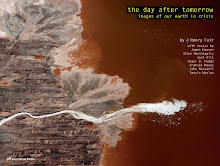Molybdenum is one of the minerals which give steel its hardness, but the quantities used are so small that the demand is limited, causing an oscillating demand, which has prompted the mining industry to mine it only periodically.
One such mine in my list of interests, is on Copper Mountain, southwest of Denver.
Also on my list to shoot are two power plants that are among the 100 largest CO2 and mercury emitters in the USA. This group of attractions, in combination with an exhibit in Denver and lecture invitation, suggested a photo flight.

Lighthawk is a group of pilots that fly for the environment, and are frequent partners in my work. Their pilot Stephanie Wells agreed to the mission, and I laid out a flight plan, which Stephanie modified with her local knowledge and experience of high altitude flying, an exacting experience set combing science, local knowledge, skill, aerodynamics, and the knowledge of her aircraft. The steel would have to wait.
We agreed to go west to the power plant at Craig, CO, the 51th largest CO2 emitter in the USA, which is also near several coal mines, one deep below ground, the other on the surface.
 |
| Trees affected by bark beetle in Colorado Rockies |
Much of the success of these projects comes from predicting and praying for the right weather, and we had luck on our appointed day. For a coast native that studies those regions, the mountains held a novel fascination- what Stephanie saw as normal was unique and beautiful to me as we crossed the “Front Range” as the mountains closest to Denver are called.

The first environmentally interesting site, a deep coal mine, had not been on my plan, but with an abiding curiosity to see these things and how they work, we circled, before moving on the the power plant at Craig. So as not to seem like a sinister character, cautious pilots limit the number of circles they will make around a power plant. We agreed to pan around it once, circle the nearby mine, and pass by again on the way back to the nearby airfield for fuel, (Stephanie had flown with a minimum for the mountain crossing) and then pass the plant again on our way to the open-pit mine. Power plants are often rather ugly affairs, and this one is no exception, being all stacks, boilers, and turbines enclosed in a utilitarian building.
 |
| Coal-fired power plant. 51th largest CO2 emitter in the USA |

Open-pit mines use drill rigs to make holes which are “charged” with ammonium nitrate to blast away the dirt (overburden) covering the object of the mine (in this case coal). The overburden is scooped and dumped to the side by a giant walking “dragline”.
After one pass around the mine, Stephanie expressed nervousness about our fuel level, so we went back to tank up from a charismatic old Coloradan gentleman at the tiny air strip (sadly, I left the cameras in the plane). As we took off again, a giant cloud filled the distant sky, and we reasoned it was a blast at the mine, probably executed after everyone left for lunch, due to the danger of flying rock. Still, it was a sight I was disappointed to miss.
 |
| Compressor trucks, well-heads and chemical tanks at fracking site |
Hydro-fracking has been a controversial gas extraction technique around the world, and Colorado is no exception. Between the close proximity to houses and schools, and the regional scarcity of water, a resource mightily depleted by this process, local people were organizing in opposition to the industry near their homes, and I was asked to get the bird’s eye view. So we came down from the mountains and out to the plains around Boulder to find the sites, and they proved to be a textbook series of illustrative examples of the process. Hydro-fracking is also a rather ugly business, visually as well as its side-effects. A giant drill makes a deep and meandering hole, then leaves to make room for a group of large, powerful compressors which pump that bore full of water and chemicals at excruciating pressure, endeavoring to fracture the gas-bearing layer of rock below.
 |
| Factory farm for cattle |
The day really seems a smashing success, even if we did not make it to see the steel, and both pilot and artist were glad to get back on the ground and run to the head.
















